Leicester City
Leicester Fosse FC was founded by a group of former public school pupils and members of a bible class who met in the Emmanuel Church in Park Street. Their unusual name is derived from a noted local landmark that dates from the Roman occupation, "Fosse" being Latin for "fortified ditch." Indeed, their first game was played on fields next to Fosse Road against Syston Fosse FC!
For seven years Leicester played only friendly matches and in cup competition but in 1888 they signed their first professional player, Harry Webb, who received 2/6d (12.5p) a week. In 1891, Leicester joined the Midland League along with local rivals Loughborough Town. After years of nomadic existence, the club finally settled into a new ground off Filbert Street that same year. Only three years later, the club was elected to Division Two of the Football League with the maximum 20 votes.
During these early years the club played in various shades of blue and white and it was not until 1903 that the royal blue shirts that would become traditional were adopted. In 1908, Fosse won promotion to Division One only to be relegated immediately.
During the First World War the club continued to play in war time competition and, because of a shortage of dye, turned out in striped shirts. These shirts continued to be worn until at least the end of the 1920-21 season. After World War One, Leaicester Fosse ceased trading and was reformed as Leicester City. In 1925, Leicester won the Second Division championship and this time retained their place at the top level for ten years. Relegated in 1935,  they bounced back again in 1937 only to be relegated once more in 1939.
they bounced back again in 1937 only to be relegated once more in 1939.
When football resumed after the Second World War, Leicester remained a modest Second Division outfit. A crest appeared on the team shirts in 1946 (some accounts suggest 1948), which included a rather poorly drawn fox's head (the county is associated with hunting) giving rise to their modern nickname, "The Foxes."
In 1949 Leicester were beaten FA Cup Finalists while narrowly avoiding the drop into the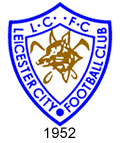 Third Division.
Third Division.
The original crude crest was replaced in 1952 with a rather more distinguished design. This usually appeared out of a white rectangle until it was stitched directly on to the shirts from 1960.
1954 brought another Second Division championship followed by yet another immediate relegation. In 1957 City won the Second Division again and this time, narrowly retained their staus and became established as a First Division side. During the 1960s, City played in three FA Cup Finals, only to lose them all. There was some compensation when the club won the League Cup in 1964 beating Stoke City over two legs in the final.
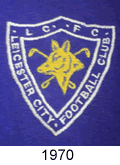 In 1969 City were relegated once more but in 1971 the club won the Second Division championship yet again. The crest was reversed out during this season. This sojourn at
In 1969 City were relegated once more but in 1971 the club won the Second Division championship yet again. The crest was reversed out during this season. This sojourn at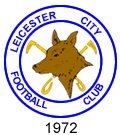 the top lasted seven years and included one season (1972-73) when the traditional colours were dropped in favour of an all-white strip. The circular crest adopted with this outfit remained in use until 1979 when the 1970 version was briefly reinstated.
the top lasted seven years and included one season (1972-73) when the traditional colours were dropped in favour of an all-white strip. The circular crest adopted with this outfit remained in use until 1979 when the 1970 version was briefly reinstated.
Between 1978 and 1983, City were relegated and promoted with bewildering regularity. At this time the young Gary Lineker emerged, a striker who would go on to a glittering international career before returning to save the club from extinction.
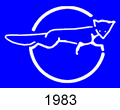 A radical new crest design, popularly known as the "walking fox," was introduced in 1983 and lasted for nine seasons.
A radical new crest design, popularly known as the "walking fox," was introduced in 1983 and lasted for nine seasons.
 In 1992, a smart new crest was introduced and the team finally returned to the top level (now the Premiership) via the play-offs in 1994. Immediately relegated, City were back again the year after, once again by the play-off route. Between 1996 and 2002 City not only consolidated at the top level but also won the League Cup twice (1997 and 2000). A traumatic period followed in October 2002 when the club went into administration after dropping into Division Two. A consortium led by Gary Lineker took the club over and guided it back into the Premiership that same season. There was a huge controversy as rival clubs complained that, by going into administration, City had been protected from their creditors while consolidating its playing staff, thus gaining an unfair advantage. As a result, League rules
In 1992, a smart new crest was introduced and the team finally returned to the top level (now the Premiership) via the play-offs in 1994. Immediately relegated, City were back again the year after, once again by the play-off route. Between 1996 and 2002 City not only consolidated at the top level but also won the League Cup twice (1997 and 2000). A traumatic period followed in October 2002 when the club went into administration after dropping into Division Two. A consortium led by Gary Lineker took the club over and guided it back into the Premiership that same season. There was a huge controversy as rival clubs complained that, by going into administration, City had been protected from their creditors while consolidating its playing staff, thus gaining an unfair advantage. As a result, League rules 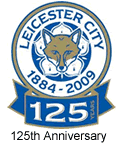 have now been changed so that any club that enters administration has ten points deducted.
have now been changed so that any club that enters administration has ten points deducted.
The club continued to rise and fall with extraordinary regularity between the top two tiers until 2008 when they were relegated to the third tier (League One) for the first time. They proved strong enough to win the League One title at the first time of asking. Their return to the Championship coincided with their 125th anniversary for which they adopted a special commemorative strip without sponsorship and a special crest.
